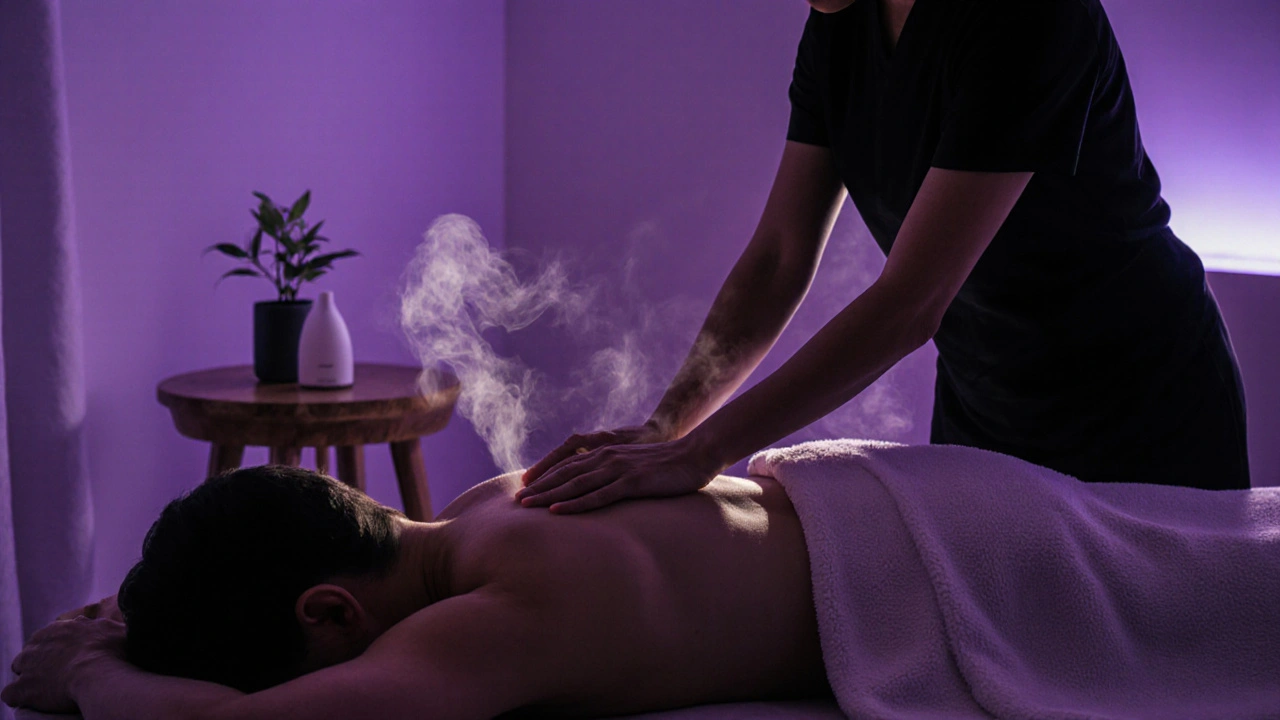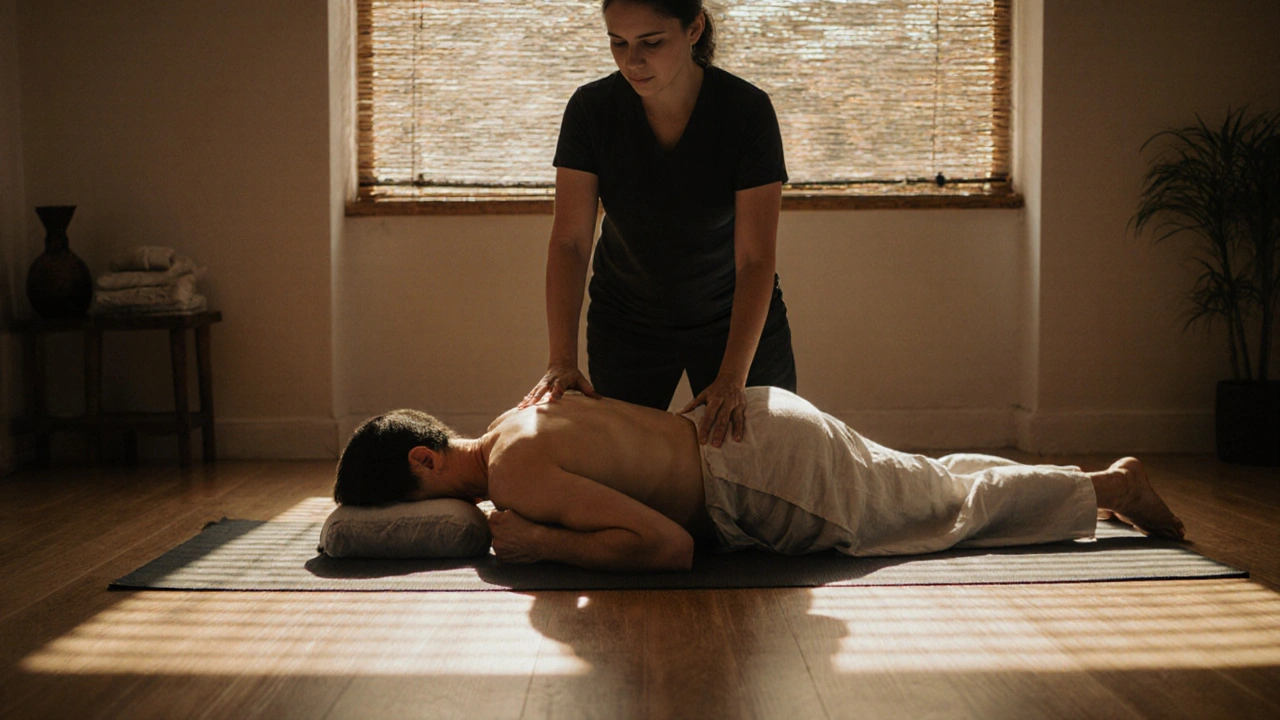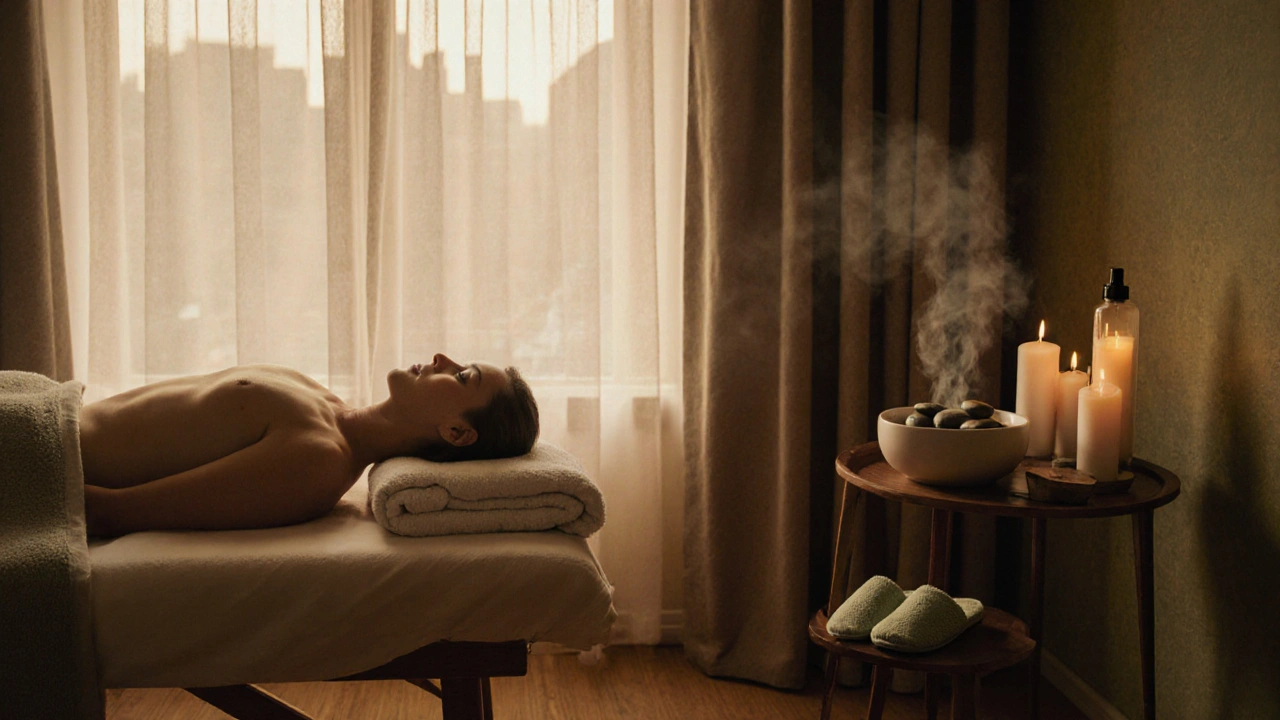Find the perfect relaxing massage near you in London. Learn what to expect, where to go, how much it costs, and how to choose the right therapist for true calm.

- Created by: Liam Redgate
- Completed on: 3 Nov 2025
- Categories: Massage Therapy
You’ve had a long week. Your shoulders are tight, your mind is buzzing, and the idea of just letting go feels like a luxury you can’t afford. But what if the perfect reset wasn’t a flight away-it was just a few subway stops from your flat? London’s massage therapy scene isn’t just about pampering. It’s a quiet revolution in how we handle stress, pain, and burnout. And it’s more accessible than you think.
What Makes London’s Massage Therapy Different?
London doesn’t just offer massages-it offers tailored healing. Unlike chain spas that use the same script for every client, here, therapists adapt. They listen. They notice the way you hold your neck when you walk in. They adjust pressure based on your breathing, not a checklist. This isn’t a one-size-fits-all experience. It’s medicine disguised as luxury.
Think about it: a Thai therapist in Camden uses rhythmic compression to release tension you didn’t even know you had. A Swedish therapist in Notting Hill blends long, flowing strokes with targeted work on your lower back. A deep tissue specialist in Shoreditch might spend 20 minutes just on your left hip-because that’s where your sciatica flares up. Each session is built around your body, not a brochure.
Why It Works: The Science Behind the Touch
Massage therapy isn’t just about feeling good. It’s backed by real physiology. A 2023 study from King’s College London tracked 120 people with chronic lower back pain over 12 weeks. Those who received weekly massage therapy reported a 40% drop in pain intensity-twice the improvement of those who only took painkillers. Why? Pressure stimulates mechanoreceptors, which calm the nervous system. It lowers cortisol. It increases serotonin. It literally rewires how your brain interprets pain.
And it’s not just for pain. People with anxiety say their racing thoughts slow down after just one session. Office workers who sit all day notice better sleep. Athletes recover faster. Even people with insomnia report falling asleep quicker after regular treatments. The body doesn’t lie. When you release physical tension, mental tension follows.
Types of Massage Therapy Available in London
London’s offerings are as diverse as its neighborhoods. Here’s what you’ll actually find:
- Swedish Massage: The classic. Gentle strokes, ideal for beginners or those seeking deep relaxation. Perfect if you’ve never tried therapy before.
- Deep Tissue Massage: For chronic knots, stiff shoulders, or old sports injuries. Uses slower, firmer pressure to reach deeper muscle layers.
- Thai Massage: Done on a mat, fully clothed. Combines yoga-like stretches with acupressure. Great if you want movement and pressure in one session.
- Hot Stone Massage: Warm basalt stones melt tension. Especially soothing for people with arthritis or cold hands/feet.
- Aromatherapy Massage: Essential oils like lavender or eucalyptus are blended into the oil. Helps with mood, sleep, or congestion.
- Lymphatic Drainage: Super gentle, rhythmic movements that help reduce swelling. Ideal after surgery, travel, or if you feel constantly bloated.
- Sports Massage: Targeted for runners, cyclists, or gym-goers. Focuses on mobility, recovery, and preventing injury.
You don’t need to pick one. Many therapists combine techniques. A session might start with Swedish to warm the tissue, then shift to deep tissue on problem areas, and end with aromatherapy to calm the nervous system.
How to Find the Right Therapist in London
Not every therapist is the same. Here’s how to cut through the noise:
- Check credentials: Look for members of the Complementary and Natural Healthcare Council (CNHC) or the Federation of Holistic Therapists (FHT). These aren’t just fancy titles-they mean they’ve passed clinical training and insurance checks.
- Read reviews with context: Skip the five-star ones that say “Amazing!” Look for reviews that mention specifics: “She adjusted my posture during the session,” or “He asked about my desk setup.” That’s a sign they care about root causes.
- Try a local studio: Chain spas like ESPA or The Spa at Mandarin Oriental are polished, but independent therapists in places like Hackney, Brixton, or Islington often offer better value and more personalized care.
- Ask for a consultation: Most therapists offer a free 10-minute chat before your first session. Use it. Ask how they handle chronic pain, what oils they use, or if they’ve worked with people like you before.
Pro tip: Google “massage therapy near me” won’t cut it. Try “licensed massage therapist [your neighborhood]” or “deep tissue massage London CNHC.” You’ll find higher-quality results.

What to Expect During Your First Session
Walk into a quiet room. Soft lighting. The scent of lavender or sandalwood. You’ll be asked to fill out a short form-health history, injuries, areas of discomfort. Don’t skip this. It matters.
You’ll undress to your comfort level. Most people keep underwear on. You’ll be covered with a towel at all times-only the area being worked on is exposed. The therapist will leave the room while you get settled.
The session starts gently. They’ll check in: “Is this pressure okay?” If it’s too much, say so. If it’s too light, say that too. A good therapist wants you to feel safe, not just relaxed.
You might hear cracking or popping-that’s normal. It’s gas in the joints, not bones breaking. You might feel a little sore afterward, especially after deep tissue. That’s your muscles adjusting. Drink water. Move gently. You’ll feel better by the next day.
Pricing and Booking: No Surprises
Here’s the real talk: prices vary, but they’re predictable.
- 60-minute session: £60-£90 (most common)
- 90-minute session: £90-£130
- 120-minute session: £130-£180
High-end hotels or central London locations (Mayfair, Knightsbridge) charge more-up to £200. But you’ll find excellent therapists in places like Walthamstow or Croydon for under £70. Many offer first-time discounts-often 15-20% off.
Booking? Most use online systems like Acuity or Calendly. You can book in 90 seconds. Some studios let you walk in, but don’t. Weekends fill up fast. Book at least a week ahead if you want a specific time.
What to Avoid
Not all “massage” services are therapy. Be careful of:
- Places that don’t list therapist qualifications
- Locations in residential areas with no official address or website
- Prices that seem too low-£30 for a 90-minute massage? That’s a red flag. Training, insurance, and rent cost money.
- Therapists who push you into packages or insist on weekly sessions right away
Therapy is a partnership, not a subscription. You should feel in control.

Massage Therapy vs. Spa Massage in London
| Feature | Massage Therapy | Spa Massage |
|---|---|---|
| Goal | Healing, pain relief, functional improvement | Relaxation, indulgence, experience |
| Therapist Training | 2+ years, anatomy, pathology, clinical practice | Weekend course, basic techniques |
| Session Customization | Highly personalized | Pre-set套餐 (fixed packages) |
| Environment | Clinic-style, quiet, focused | Luxurious, noisy, often with music or steam |
| Aftercare Advice | Stretching, hydration, posture tips | Tea and a cookie |
| Typical Price (60 min) | £60-£90 | £90-£180 |
Spa massages feel amazing-until you leave and the pain comes back. Therapy massages feel like a reset. You leave with tools, not just temporary relief.
Frequently Asked Questions
Can massage therapy help with migraines?
Yes. Tension headaches and migraines are often linked to tight neck and shoulder muscles. A 2022 trial at the University of Westminster found that participants who received weekly massage therapy for eight weeks reduced migraine frequency by 50%. Therapists focus on the suboccipital muscles-the ones at the base of your skull-which are rarely targeted in standard spa treatments.
Is massage therapy safe during pregnancy?
Absolutely-but only with a therapist trained in prenatal massage. Regular massage can be risky in early pregnancy or if you have high blood pressure. Look for CNHC-certified therapists who specialize in pregnancy. They use side-lying positions, avoid pressure points, and adjust oils to be pregnancy-safe. Many women report better sleep, less back pain, and reduced anxiety after regular sessions.
How often should I get a massage?
It depends. If you’re dealing with chronic pain or injury, once a week for 4-6 weeks is common, then taper to every 2-4 weeks. For stress or maintenance, once a month keeps your body in balance. Think of it like brushing your teeth-you wouldn’t wait until your gums bleed. Regular care prevents bigger issues.
Do I need to be naked?
No. You’re covered with a towel at all times. Most people keep their underwear on. If you’re uncomfortable, say so. A good therapist will adapt. Your comfort is part of the healing process.
What if I’m not relaxed during the session?
That’s normal-especially the first time. Many people worry they’re “doing it wrong.” Don’t. Just breathe. Let your body sink into the table. The therapist isn’t judging you. They’ve seen it all: people crying, laughing, snoring, or even falling asleep. Your job is to show up. They’ll do the rest.
Ready to Feel Like Yourself Again?
You don’t need to wait for a vacation to feel whole. London’s massage therapy scene is built for people like you-busy, tired, and ready to stop ignoring their body’s signals. It’s not a luxury. It’s a tool. And it’s waiting for you, just around the corner.
Book your first session this week. Not next month. Not when you have more time. Right now. Your shoulders, your mind, and your future self will thank you.
Discover how London's massage therapy goes beyond relaxation to deliver real pain relief and stress reduction. Learn about types, pricing, how to choose a therapist, and what to expect in your first session.
Discover how a regular body massage in London eases stress, improves sleep, and boosts wellbeing. Practical tips, pricing, and what to expect included.



j t
November 4, 2025 AT 23:40you ever just sit there after a massage and realize you forgot how to breathe normally? like your body was holding its breath for 37 years and now it’s like… oh right, air exists? i got one in brooklyn last month and i cried in the car on the way home. not because it hurt, but because i realized i hadn’t felt my own shoulders in years. i didn’t know i was walking around with a brick taped to my spine. now i just stare at the ceiling and wonder why everyone doesn’t do this. why are we still treating pain like it’s a moral failing?
Melissa Perkins
November 5, 2025 AT 11:55This is so beautifully written. I used to think massage was just a fancy spa treat, but after my chronic lower back pain didn’t improve with meds, I tried a CNHC-certified therapist in Portland. It wasn’t magic-it was science. I started noticing my posture during Zoom calls, drinking more water, even stretching at my desk. It’s not about pampering. It’s about listening to your body before it screams. If you’ve been putting it off, just book it. Your future self will hug you.
Jimmy Carchipulla
November 6, 2025 AT 00:56just booked mine 😍
Sriram T
November 6, 2025 AT 17:06OMG I CANNOT BELIEVE YOU GUYS ARE STILL TALKING ABOUT THIS LIKE IT'S SOMETHING NEW 😭 i've been getting thai massage in bangkok since i was 14, and now i come to london just for the lymphatic drainage?? like bro, this is basic human maintenance. why are you acting like this is a revelation? i saw a woman in camden cry because she finally felt her pelvis again. i cried too. not because i'm soft, but because the world is so broken. we are all just walking corpses with tight hamstrings and unprocessed trauma. massage is the only therapy that doesn't charge you $300/hour to say 'i hear you'. 🙏
Jonny BiGSLiCE
November 7, 2025 AT 03:22There’s a profound shift happening in how we conceptualize bodily care. Traditional medicine treats symptoms; massage therapy addresses the somatic roots of systemic dysfunction. The physiological mechanisms-mechanoreceptor stimulation, cortisol reduction, parasympathetic activation-are not anecdotal. They’re empirically validated. What’s remarkable is the cultural resistance to accepting non-pharmaceutical, non-invasive modalities as legitimate healthcare. We’ve been conditioned to equate value with cost and complexity, yet the most effective interventions are often the simplest. This isn’t luxury. It’s preventative neurology.
Luke Ollett
November 9, 2025 AT 03:16Let’s be real-most people who say ‘massage therapy’ are just trying to sell you a $120 package so they can pay rent. The ones who actually know anatomy? They’re the ones with 12 years of training, a tiny studio above a laundromat in Peckham, and no Instagram. The spa? They’ve got chandeliers and lavender-scented steam rooms. The therapist who remembers your sciatica? She’s got a 2015 Toyota and a notebook full of clients who haven’t missed a session in five years. Don’t pay for ambiance. Pay for expertise. And yes, if someone charges £30 for 90 minutes, they’re either lying or illegally operating. Don’t be the reason they can’t afford liability insurance.
Trent Thevenot
November 10, 2025 AT 13:36Ugh. I hate how this post romanticizes ‘healing’ like it’s some mystical cure-all. Massage doesn’t ‘rewire your brain.’ It temporarily reduces muscle tension. You’re conflating relief with resolution. And let’s not pretend this is accessible. £90 for an hour? That’s a full day’s wage for someone working minimum wage. This isn’t therapy-it’s a privilege for the middle class who can afford to ignore their systemic stressors. Meanwhile, people are choosing between insulin and rent. Don’t turn bodily discomfort into a wellness influencer fantasy.
Kiana Rigney
November 12, 2025 AT 06:30You’re all missing the point. This isn’t about massage. It’s about capitalism commodifying pain. They took something primal-human touch-and turned it into a £180 experience with organic oils and Spotify playlists. The real therapy? Someone sitting with you without trying to fix you. A hand on your shoulder. A silence that doesn’t need to be filled. That’s what’s missing. Not the pressure points. Not the CNHC certifications. Just… presence. And you can’t book that.